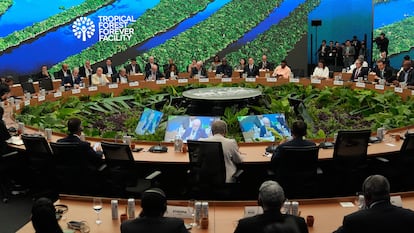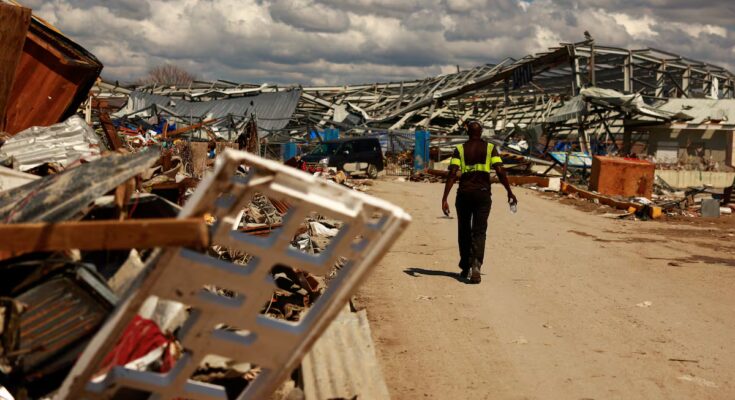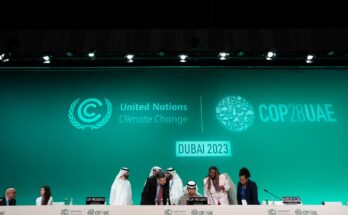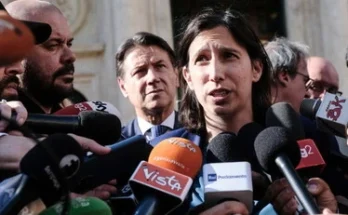EL PAÍS openly proposes the América Futura column for its daily and global informative contribution on sustainable development. If you want to support our journalism, subscribe Here.
The United Nations climate change conference returns to Latin America and the Caribbean after 11 years. And it does so in the Amazon, in the city of Belém do Pará, Brazil. COP30 also comes at a time of crisis for the region. It is convened by President Luiz Inácio Lula da Silva, who resumed the climate discourse after the exit of Jair Bolsonaro from these international stages and is the last under the governments of Gabriel Boric (Chile) and Gustavo Petro (Colombia), who promoted the climate agenda; It is also the first time that Claudia Sheinbaum, Mexican president and climate scientist, can officially showcase her policies: at the previous meeting, COP29, she had only been in power for a month. At the conference, Latin Americans and Caribbeans will also measure how strong they are in the absence of the United States – which has called for exiting the Paris Agreement – and will come with a very current precedent: the passage of the devastating Hurricane Melissa through the Caribbean, strengthened by climate change.
“COP30 comes at a turning point,” comments Jorge Villarreal Padilla, director of climate policy at the Mexico Climate Initiative. There are several governments pursuing the thesis of energy sovereignty and it is increasingly clear that the region is not only affected by the climate crisis, but also by debts and inequalities. “The challenge is to increase funding to adapt,” he says.
This is what is at stake in Latin America and the Caribbean at COP30:
Back on climate commitments
When the Paris Agreement was signed in 2015, it was stipulated that countries had to submit a plan to the UN to reduce their emissions with voluntary targets, known as NDCs. Every five years these commitments had to be updated. And although the ideal date to present the third version was early 2025, few countries in the region have done so, only 14 out of 50, according to Climate Watch. Colombia presented what it called a “declarative version”, a sort of draft with the main elements, and said it would have its final version, with specific objectives, in December. Brazil, for its part, fulfilled its task a year early and revealed at the 2024 COP that, by 2035, it wants to reduce its emissions by between 59% and 67% compared to those generated in 2005.

The Argentine government, led by denier Javier Milei, has said it will present its commitments in the first week of COP30, like Mexico.
Fractures and unions
The position of Donald Trump, president of the United States, in favor of promoting fossil fuels represented a test for Latin America and the Caribbean: join him or face him. And, at least in discourse, the majority of countries chose the second option. In August, after a meeting in Mexico between ministers and representatives of 22 Latin American and Caribbean countries, a declaration was signed in which it is clear that it is necessary to achieve a transition that leaves fossil fuels behind in a manner consistent with sustainable development.
Although contradictions exist between countries, even within the same states, for Alejandra López Carbajal, director of climate diplomacy at the think tank Transforma, it is a sign that alignment is starting to exist between the different blocs under which the region negotiates. Since COP28, two years ago, it was agreed for the first time to “abandon fossil fuels”, with a “just, orderly and equitable” transition. “What we hope for from Latin America, at least from civil society,” he assures, is that a date and calendar are set for this release. Not all at once, but progressively. First the more developed countries and then the less developed ones, and often historically less responsible for climate change. By fuel type and economy. “I will be optimistic. We have the possibility to leave the COP in Belém with a clearer roadmap on how to do it. Brazil has this diplomatic capacity,” he says.

The challenge is bigger. Brazil itself, host of the event, has its fractures, as Claudio Angelo, coordinator of international politics at the Observatório do Clima, explains. “We are two countries. In the climate commitments (NDC), it says that we intend to bring forward a timetable to exit from fossil fuels. But last month, Brazil also granted new licenses for exploitation in the Amazon.”
This last point shows how, paradoxically, countries also distance themselves. During the Amazon summit in Bogotá in August, nothing was left in the final document about the indigenous people’s petition to curb gas, oil and coal in the world’s largest rainforest. Petro supported it: in 2026 Colombia will host the first international conference for the progressive elimination of fossil fuels. But Venezuela, Ecuador and Peru opposed it. Lula, once again, argued that the exploitation of hydrocarbons at this time can finance “the energy transition that Brazil needs”.
From the Caribbean, civil society arrives at COP30 with the same flag. Carolina Sánchez Naranjo, of the Greater Fossil-Free Caribbean Network, which brings together regional and local organizations from 12 countries (Belize, Colombia, Costa Rica, Guatemala, Guyana, Honduras, Bahamas, Panama, Dominican Republic, Saint Lucia, Suriname and Venezuela), explains that, although they have less visibility or their leadership does not make as much noise, there is concern about the arrival of hydrocarbon projects, especially at sea. “Guyana has become a petrostate in record time,” they comment. In Panama, the government has considered the idea of marine exploration, while the Dominican Republic is exploring alliances with Guyana to exploit gas and oil. The Network is also calling on COP30 to establish the Caribbean as a fossil exclusion zone. “We are strongly supporting Amazonian organizations in their proposal for vital zones,” he comments. “Starting from that jungle, but with us back there, almost at the same time.”
But at COP30 the Region also plays the most difficult card to obtain: money. Just as countries come together to decipher, among other things, how to increase climate finance to “at least 1.3 trillion dollars per year by 2035”, the Bolivian Carola Mejía, coordinator of Climate Justice, Transitions and Amazon at Latindadd, recalls some data: Latin America and the Caribbean receive only 17% of global climate finance and, of these, 81% are loans. “We’re not asking for solidarity or charity. It’s something related to reparations and climate justice,” he says.



